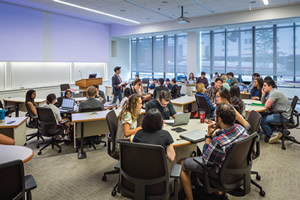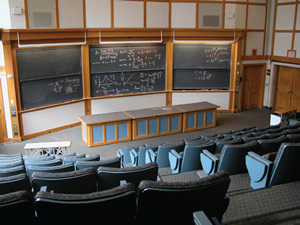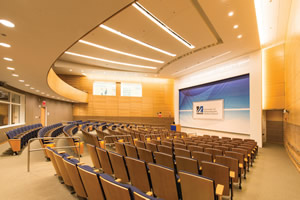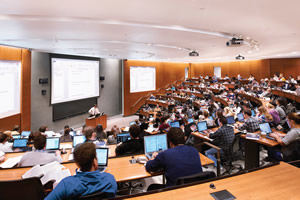Active Learning and Case Study Classrooms
- By Jonah Sacks, Larry McIntyre
- 05/01/16

PHOTO © PETER AARON (OTTO ARCHIVE)
Some years ago, an architect
friend and past client called with
an issue: He had designed a new
graduate school classroom, and there were
some acoustical problems. It was a large,
flat-floor room for up to 125 students, with
moveable tables and chairs. The teaching
model, called “active learning” or “teambased
learning,” incorporated several
classroom modes into each class session.
The instructor first addressed the class and
introduced a study problem. Students then
worked through the problem in groups of
six to eight, with each group sitting around
its own table. Video displays mounted on
walls around the room presented relevant
facts about the study problem. After a set
time had elapsed, each group presented its
solution orally to the class.
In concept, this model is no different
than what primary and secondary schools
have practiced for generations. But adapting
this familiar teaching model to a large
classroom of 125 students rather than 30,
with work groups of six or eight rather
than three or four, proved challenging.
Amplification was required for one person
to speak and be heard by the entire room.
In this room, microphones and loudspeakers
were located in the ceiling, and a “mix-minus” signal-processing algorithm
was intended to activate only the microphone
closest to the person speaking
and deactivate the loudspeakers closest
to that microphone. The system was
easily overwhelmed during group-work
mode as up to 20 separate groups around
the room talked and sometimes argued
through their study problems, often quite
enthusiastically. Overall sound levels in
the classroom during these times could
get quite loud, making discussions difficult.
Additionally, the moveable furniture
meant that microphones were not always
located directly above student tables and
did not always amplify speech effectively.
Students were often asked to speak up and
repeat themselves when presenting their
groups’ solutions.

PHOTO © COLLEEN ANDERSON
What went wrong with this design,
and what can we do to get it right in other
classrooms? Let’s take a step back and look
at several traditional classroom models
and their acoustical designs.
From Traditional to Today
Traditional primary and secondary
school classrooms for 20 to 30 students
accommodate a variety of teaching modes:
instructor speaking to the class, full-class
question/answer and discussion, individual
teacher-student interaction and
student group work. To control buildup
of noise when many students are talking,
and to promote clarity and intelligibility of
speech, sound-absorbing ceilings are typically
included in all such classrooms and
are required by relevant classroom design
standards, such as LEED, CHPS and ANSI
S12.60. Because of the typical classroom
size speaking distances are small, and
amplification is not required.

PHOTO COURTESY OF ARC/ARCHITECTURAL RESOURCES CAMBRIDGE, © PETER VANDERWARKER
ARE YOU GOING SOFT ON ME? A classic university lecture hall, such as the one seen to the left, was designed with hard
surfaces that reflected an instructor’s voice to students’ ears. But reflection of sound adds reverberation, which adds
distortion and can result in unintelligibility. Today’s lecture halls, such as the one above, are being designed with softer,
sound-absorbing surfaces and furnishings, reducing reverberation and echoes. The science of sound has led designers to
techniques and materials, as well as technologies, which create an optimal acoustical lecture environment that provide
crisp and intelligible sound throughout the room.
Lecture and assembly halls are
designed for one instructor or presenter
to address a large number of students
or audience members. Before the arrival
of speech amplification, this required
big voices and clear diction. Design of
such rooms often included hard surfaces
to reflect the instructor’s voice to the
students’ ears, naturally reinforcing the
speech while adding reverberation that
challenges intelligibility. This design approach
still applies today for performing arts theaters and other rooms intended
for unamplified speech to large audiences.
However, modern collegiate lecture
halls are typically designed for amplified
speech, and should be equipped with
a properly designed sound system and
sound-absorbing surfaces to promote
clarity and intelligibility of that amplified
speech.
Many collegiate lecture rooms of up
to around 125 seats in size are used for
what is sometimes called “case study”
learning, which is a mix of lecture and
seminar modes. The instructor will often
be amplified and will lead a discussion
among the class, while students are speaking
unamplified. Allowing students to hear
one another from any location in the room
requires several design features:
- Very low background noise from HVAC
and other equipment,
- sound-reflecting ceiling surfaces in the
front and center of the room, and
- sound-absorbing wall surfaces at the
sides and rear of the room.
The combination and locations of
sound-reflecting and sound-absorbing
surfaces allow students’ voices to be
naturally reinforced across the room, while
at the same time controlling reverberation
that could impede clarity and intelligibility.
Equally important is the layout and
furniture configuration. To keep speaking
distances as close as possible, seating is
typically fixed and dense, and the floor is
often tiered to allow clear and direct lines
of sight and sound among students.

PHOTO © DAVID LAMB PHOTOGRAPHY
HEAR AND BE HEARD. In Cornell University Law School’s Hughes Hall and Myron Taylor Hall, lecture halls are designed to
include three projectors and projection screens as well as two large confidence monitors to allow the presenter to see what
is displayed on the screens without having to turn around. The lecture halls are also equipped with sophisticated audio
systems, including both microphones on the student desks and suspending from the ceiling, in order to support speech
reinforcement and distance learning. Furthermore, videoconference codecs for distance learning and class capture appliances
were installed to enable recording and storing classes for later review by students.
Accommodating
Active Learning
The active learning model, with its
flexible furniture layout, larger floor plan
area per student and multiple speech and
discussion modes, requires a very different
design approach than these traditional
models. Speaking distances are often too
far to realistically allow for unamplified
speech across the room, particularly when
other students may be carrying on sidebar
conversations with members of their group.
In group-working mode, with its multiple
simultaneous discussions at many tables,
the room behaves acoustically more like
a cafeteria than a classroom, and sound-absorbing
material at the entire ceiling is
needed to control buildup of activity noise.
A speech-reinforcement system must be
thoughtfully designed to allow amplification
of only the intended speaker. Often, the best
approach is to include push-to-talk tabletop
microphones. If the furniture positions are
fixed, ceiling heights are within reason and
background noise is properly controlled,
ceiling microphones may also be an option.
In either case, a distributed ceiling loudspeaker
system and mix-minus signal-processing
algorithm are generally appropriate.
To support flexibility, microphones may
be connected to Ethernet ports and audio-distributed
by the data network, avoiding the
need for dedicated audio cabling.
Today’s college and university classrooms
are innovating in many ways, combining
and extending teaching methods
that challenge our design practices. More
than ever, designers must work to understand
in detail how these rooms will be
used so that our designs respond appropriately,
and so that instructors and students
can hear and understand one another
clearly and easily.
MAKING SENSE OF MIX-MINUS
Relative to audio engineering, a
mix-minus is a particular setup, such that
the output to a certain device contains
everything except the input from that
device. Mix-minus, which is technically
accomplished via a wiring and patching
configuration, prevents echoes or feedback
from reverberating or howling and
squealing through the broadcast or sound
reinforcement system. A mix-minus signal
is sometimes also known as a “clean
feed” or a “Select Audio Return (SAR).”
A common example is in the field of
sound reinforcement. Consider a room with
sound stations for multiple users, each
station containing a microphone and a
loudspeaker. The microphone in station #1
would feed the loudspeakers in every other
station except station #1. In other words,
station #1 receives a mix of all microphones
minus the station #1 microphone. This
enables all participants to hear each
other clearly but minimizes problems with
acoustic feedback.
This article originally appeared in the issue of .